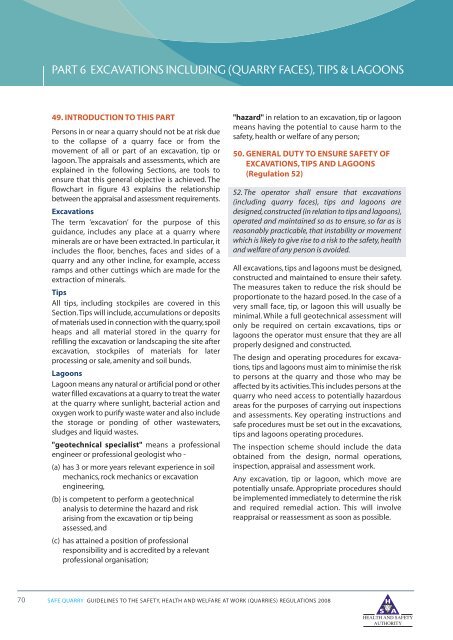Safe Quarry - Health and Safety Authority
Safe Quarry - Health and Safety Authority
Safe Quarry - Health and Safety Authority
Create successful ePaper yourself
Turn your PDF publications into a flip-book with our unique Google optimized e-Paper software.
PART 6 EXCAVATIONS INCLUDING (QUARRY FACES), TIPS & LAGOONS<br />
49. INTRODUCTION TO THIS PART<br />
Persons in or near a quarry should not be at risk due<br />
to the collapse of a quarry face or from the<br />
movement of all or part of an excavation, tip or<br />
lagoon. The appraisals <strong>and</strong> assessments, which are<br />
explained in the following Sections, are tools to<br />
ensure that this general objective is achieved. The<br />
flowchart in figure 43 explains the relationship<br />
between the appraisal <strong>and</strong> assessment requirements.<br />
Excavations<br />
The term ‘excavation’ for the purpose of this<br />
guidance, includes any place at a quarry where<br />
minerals are or have been extracted. In particular, it<br />
includes the floor, benches, faces <strong>and</strong> sides of a<br />
quarry <strong>and</strong> any other incline, for example, access<br />
ramps <strong>and</strong> other cuttings which are made for the<br />
extraction of minerals.<br />
Tips<br />
All tips, including stockpiles are covered in this<br />
Section.Tips will include, accumulations or deposits<br />
of materials used in connection with the quarry,spoil<br />
heaps <strong>and</strong> all material stored in the quarry for<br />
refilling the excavation or l<strong>and</strong>scaping the site after<br />
excavation, stockpiles of materials for later<br />
processing or sale, amenity <strong>and</strong> soil bunds.<br />
Lagoons<br />
Lagoon means any natural or artificial pond or other<br />
water filled excavations at a quarry to treat the water<br />
at the quarry where sunlight, bacterial action <strong>and</strong><br />
oxygen work to purify waste water <strong>and</strong> also include<br />
the storage or ponding of other wastewaters,<br />
sludges <strong>and</strong> liquid wastes.<br />
"geotechnical specialist" means a professional<br />
engineer or professional geologist who -<br />
(a) has 3 or more years relevant experience in soil<br />
mechanics, rock mechanics or excavation<br />
engineering,<br />
(b) is competent to perform a geotechnical<br />
analysis to determine the hazard <strong>and</strong> risk<br />
arising from the excavation or tip being<br />
assessed, <strong>and</strong><br />
(c) has attained a position of professional<br />
responsibility <strong>and</strong> is accredited by a relevant<br />
professional organisation;<br />
"hazard" in relation to an excavation, tip or lagoon<br />
means having the potential to cause harm to the<br />
safety, health or welfare of any person;<br />
50. GENERAL DUTY TO ENSURE SAFETY OF<br />
EXCAVATIONS, TIPS AND LAGOONS<br />
(Regulation 52)<br />
52. The operator shall ensure that excavations<br />
(including quarry faces), tips <strong>and</strong> lagoons are<br />
designed, constructed (in relation to tips <strong>and</strong> lagoons),<br />
operated <strong>and</strong> maintained so as to ensure, so far as is<br />
reasonably practicable, that instability or movement<br />
which is likely to give rise to a risk to the safety, health<br />
<strong>and</strong> welfare of any person is avoided.<br />
All excavations, tips <strong>and</strong> lagoons must be designed,<br />
constructed <strong>and</strong> maintained to ensure their safety.<br />
The measures taken to reduce the risk should be<br />
proportionate to the hazard posed. In the case of a<br />
very small face, tip, or lagoon this will usually be<br />
minimal. While a full geotechnical assessment will<br />
only be required on certain excavations, tips or<br />
lagoons the operator must ensure that they are all<br />
properly designed <strong>and</strong> constructed.<br />
The design <strong>and</strong> operating procedures for excavations,<br />
tips <strong>and</strong> lagoons must aim to minimise the risk<br />
to persons at the quarry <strong>and</strong> those who may be<br />
affected by its activities.This includes persons at the<br />
quarry who need access to potentially hazardous<br />
areas for the purposes of carrying out inspections<br />
<strong>and</strong> assessments. Key operating instructions <strong>and</strong><br />
safe procedures must be set out in the excavations,<br />
tips <strong>and</strong> lagoons operating procedures.<br />
The inspection scheme should include the data<br />
obtained from the design, normal operations,<br />
inspection, appraisal <strong>and</strong> assessment work.<br />
Any excavation, tip or lagoon, which move are<br />
potentially unsafe. Appropriate procedures should<br />
be implemented immediately to determine the risk<br />
<strong>and</strong> required remedial action. This will involve<br />
reappraisal or reassessment as soon as possible.<br />
70<br />
SAFE QUARRY GUIDELINES TO THE SAFETY, HEALTH AND WELFARE AT WORK (QUARRIES) REGULATIONS 2008
















